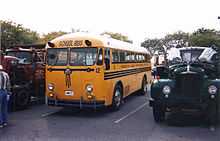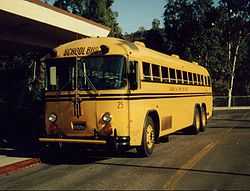Crown Supercoach
| Crown Supercoach | |
|---|---|
 1977-1991 Supercoach (retired) at a UK bus rally | |
| Overview | |
| Manufacturer | Crown Coach Corporation |
| Body and chassis | |
| Doors | Single-door |
| Floor type | High-floor |
| Chassis |
Crown Coach; underfloor or rear engine Single or tandem rear axles |
| Powertrain | |
| Engine |
Gasoline Hall-Scott Diesel CumminsDetroit Diesel Caterpillar |
| Capacity | 72-97 |
| Power output | 210-335 hp |
| Transmission |
4-speed automatic 6-speed automatic 5-speed manual 10-speed manual |
| Dimensions | |
| Length | 35-40 feet |
| Width | 96 inches |
| Chronology | |
The Crown Supercoach is a Type D (transit-style) school bus that was built by Crown Coach Corporation from 1948 to 1991. It was produced in Southern California for 43 years until Crown Coach closed its doors in March 1991. Although the Supercoach was sold primarily as a school bus, it served as the basis for Crown's motorcoaches; a wide variety of specialty vehicles were also custom-built using the Supercoach body and chassis.
Design History
1932-1948
Crown Coach first used the Supercoach model name in 1932 when it built its first transit-style school bus. The first Supercoach was of a front-engine design similar to today's Type D school buses; it predated the Blue Bird All American by 16 years. It was also one of the first buses whose body was constructed primarily of steel instead of wood. During the 1930s, Crown built motorcoaches alongside its school buses, and in an effort to increase passenger room, its first mid-engine bus (with a front-mounted radiator) was built in 1937. In 1939, the company built its school bus with a rear-mounted engine. Following World War II, Crown entered into several joint ventures to save on development costs and to restart bus production; the most notable involved Crown becoming the West Coast distributor for Indiana manufacturer Wayne Works.
1948-1960

In 1946, development began on an all-new Supercoach. Originally designed as a sightseeing motorcoach, the Supercoach entered production in 1948; school bus production began a year later. Breaking from precedent, the chassis featured unibody construction. Although the frame itself was steel, the body panels were rust-resistant aluminum. In the early 1950s, two additions were made to the Supercoach lineup. In 1954, as diesel engines became popular in large trucks, Crown introduced diesel engines to the school bus industry with the option of the mid-mounted Cummins NHH inline-6. As student populations had risen through the 1950s, larger-capacity school buses had become popular out of necessity. In 1955, Crown introduced the tandem-axle Supercoach, with a 91 (with an option for 97)-student capacity; this was the highest capacity school bus ever mass-produced.
1960-1977

In 1960, the body of the Supercoach underwent its first set of modifications since its introduction 12 years earlier. To enhance driver visibility, the windshield was enlarged. Also, the taillamps were moved from the doors of the luggage compartment to the rear corners of the bus.
Alongside the standard 220-hp Cummins NHH diesel, a turbocharged 262-hp variant was added; alongside the Cummins engine, Crown added the Detroit Diesel 671 as an option during the 1960s.
In 1973, the 743 cubic-inch Cummins NHH diesel was replaced by the 855 cubic-inch NHH diesel, requiring internal structural updates to the frame. From the outside, 1973-1977 Crown school buses are distinguishable by flat-topped wheel wells.
1977-1991

During the 1977 model year, federal regulations took effect that forever changed school bus design in the United States. To better protect passengers from crashes and rollovers, the structures of many school buses had to be updated; the metal-backed seats seen for decades were replaced by thickly padded, taller seats. Aside from the redesign of the passenger seats, which lead to minor capacity reductions, the structure of the Supercoach needed relatively few changes to meet the new regulations; the company had gone on to claim that the Supercoach was compliant as far back as 1950.[1] Post-1977 Supercoaches are distinguished by larger pillars behind the drivers' window and entry door as well as the fixed window next to the side emergency door.
In the late 1980s, along with the Crown Supercoach Series II, Crown began to expand the Supercoach lineup beyond its traditional two models. In 1988, a 38' version (84-passenger) was introduced. In 1989, two new 40' versions were introduced: a rear-engine and a single rear axle mid-engine.
The Supercoach would outlive the Series II, ending production as Crown Coach closed its doors in March 1991.
Supercoach Series II

The Crown Supercoach Series II was introduced during 1989 during an effort to fit the Crown Supercoach with a methanol-fueled version of the Detroit Diesel 6V92. As the 6V92 did not fit in the rear of the Supercoach without significant modification, Crown gave its school bus its first major update in nearly 40 years. While the windows and the lower body were shared with its predecessor, the roof, drivers' compartment, and bodywork from the rear axle aft was squared off. Inside, the instrument panel was modernized.
Along with the 6V92, the Series II was available with Cummins C8.3 and Caterpillar 3208 diesels in a rear-engine version, mid-engine versions were available with a Detroit Diesel 671. The last Series II was produced in 1990.
Powertrain
- Gasoline
- Waukesha
- Hall-Scott
- International
- Ford
- Diesel
- Caterpillar 3208 (rear-engine Supercoach II and Firecoach only)
- Cummins NHH (743 & 855 c.i.)
- Cummins C8.3 (rear-engine)
- Detroit Diesel 6v53, 6n71, 8v71, 6v92, 8v92
References
External links
| Wikimedia Commons has media related to Crown Supercoach buses. |
| ||||||||||||||||||||||||||||||||||||||||||||||||||